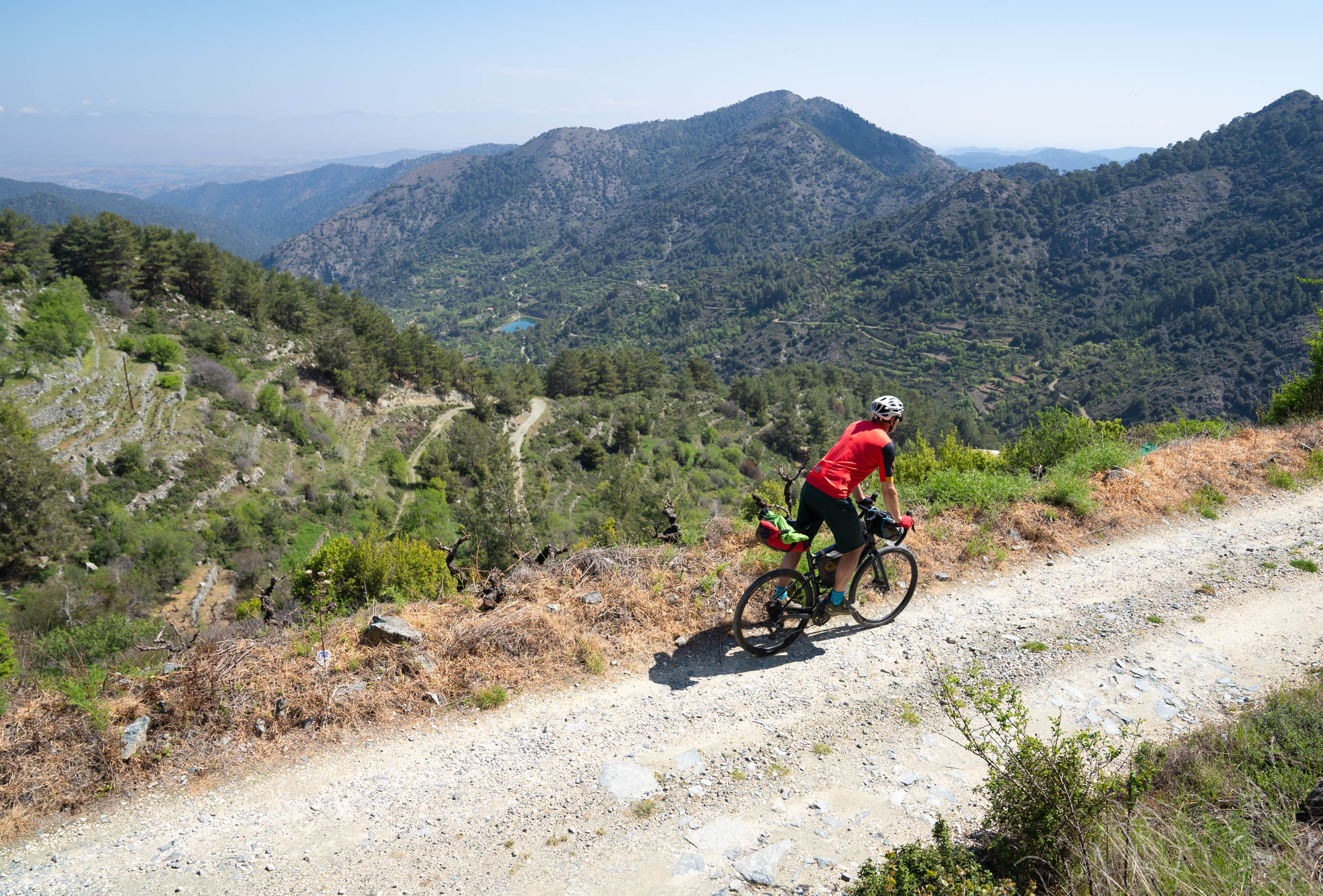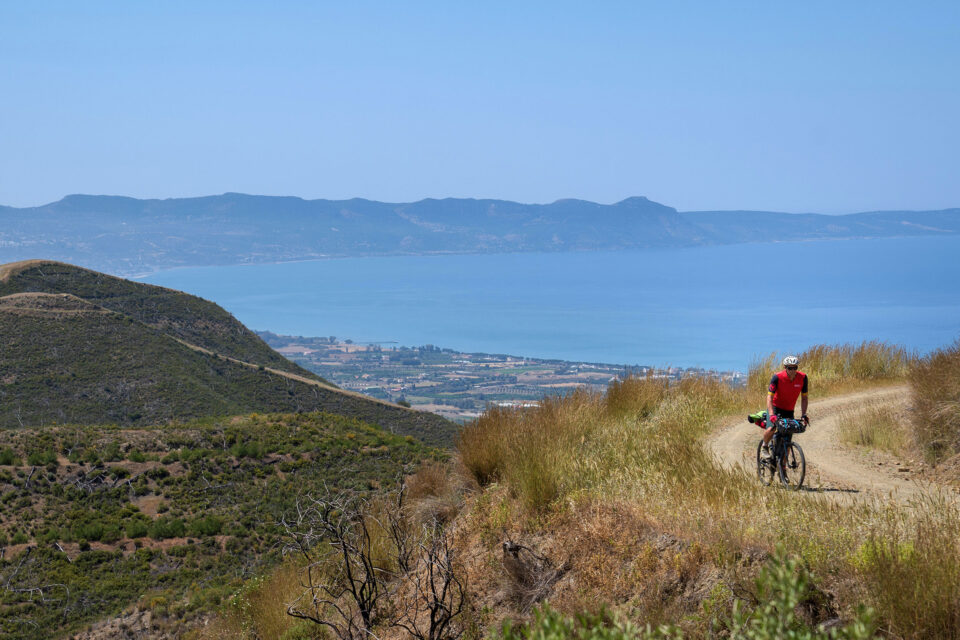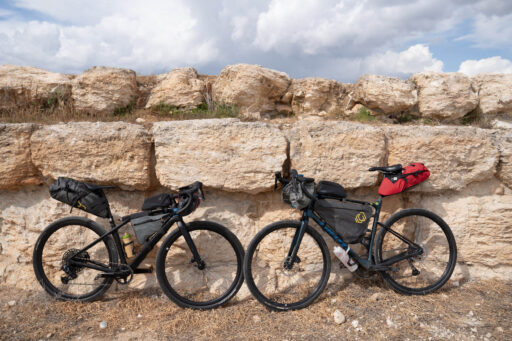Cyprus Crossing
Distance
208 Mi.
(335 KM)Days
7
% Unpaved
60%
% Singletrack
0%
% Rideable (time)
98%
Total Ascent
24,273'
(7,398 M)High Point
6,330'
(1,929 M)Difficulty (1-10)
6?
- 8Climbing Scale Strenuous117 FT/MI (22 M/KM)
- 6Technical Difficulty Moderate
- 7Physical Demand Difficult
- 4Resupply & Logistics Fair
Contributed By

Amy Jurries
Guest Contributor
Amy is an outdoor and adventure travel writer based in San Francisco. When not exploring far off places on her bike, she can be found hanging off frozen waterfalls or backpacking with her dog, Lola. Follow more of Amy’s adventures on Instagram @thegearcaster
Best known for its crystal clear Mediterranean beaches, Cyprus is home to a wide variety of terrain, from spiky cacti and fragrant orange groves at lower elevations to the pine forests of Troodos National Park and Paphos Forest at higher elevations and a stunning coastal track leading to the steep rolling limestone hills of Cypriot wine country.
Far away from the holidaymakers occupying the sun loungers and beach bars, this bikepacking route takes you to parts of Cyprus where few tourists travel. We ran into only one other person while riding off-road—Kyriakos, the sage older gentleman who embodied the gentle spirit of a simple life spent in nature.
The route is roughly 60% unpaved, using a combination of remote mountain roads through precariously perched villages, chunkier limestone tracks at lower elevations, and pristine pine forest trails up in Troodos and Paphos Forest. I rode a Specialized Diverge STR with 42mm tires and found it to be the perfect bike for the terrain, thanks in part to the small amount of front and rear suspension that reduced fatigue and smoothed out the rougher stuff. You won’t go wrong with a hardtail that might let you open up a little more on the long descents and have a bit of fun.
Get ready for some relentless climbing and incredibly steep sections. Throughout Cypriot wine country south of Lysos, you’ll find plenty of hike-a-bike both up and down, as some of the grades are unreal into and out of the valleys.
The route passes through small villages across the island, so resupply is relatively easy, mostly at the beginning and end of each day. Keep in mind that shops close for a siesta period in the mid-afternoon. We also found that many restaurants and shops weren’t yet open for the season in early to mid-April.
Route development: The Cyprus Crossing was developed through extensive research of existing gravel and mountain bike routes in the area with alterations made while scouting. Many thanks to local bike shop owner Steve from Bicycle Works in Limassol for suggestions and recommendations.
Highlights
Must Know
Camping
Food/H2O
Trail Notes
- Cypriot Food and Wine: Cypriot cuisine is a tantalizing blend of Mediterranean flavors and influences from neighboring Greece, Turkey, and the Middle East. Halloumi, souvlaki, fresh seafood, mezes, meatballs, and moussaka regularly feature on the menu. Complementing these culinary delights is Cypriot wine, with vineyards producing a variety of robust reds, crisp whites, and sweet dessert wines.
- Mediterranean Sea Swim: Whether at the beaches of Paphos or Pomos, it’s impossible to resist the allure of the azure waters of the Mediterranean. Visibility is remarkable, allowing you to admire the vibrant marine life and intricate rock formations below.
- Pristine Gravel Forest Roads: I dare you not to smile as you explore the vast, empty network of gravel forest roads and doubletrack through Troodos National Forest Park and Paphos Forest. At lower elevations, keep an eye out for the Calabrian pine, identifiable by its reddish-brown bark. As you gain altitude, the landscape transforms, dominated by the black pine. These hardier pines are the true Cypriot mountain dwellers, their dark green needles blanketing the higher slopes.
- Cyprus’ Strade-Bianche: The sun-soaked wine country south of Lysos unfolds like a patchwork quilt of rolling hills and verdant vineyards, crisscrossed by white gravel farm roads that meander through the landscape like ribbons of chalk. Beware, however, as they are steep!
- UNESCO Sites: Cyprus boasts a rich tapestry of cultural and historical heritage, with several UNESCO World Heritage Sites scattered across the island. Among them are the Painted Churches in the Troodos Region, a collection of Byzantine churches adorned with vibrant frescoes that depict scenes from the Bible and Christian iconography. The Paphos Archaeological Site, with its awe-inspiring ruins of ancient palaces, theaters, and tombs, bears witness to Cyprus’s importance in antiquity as a center of culture and civilization. Cyprus’s geological heritage is equally captivating, earning recognition with its inclusion of the Troodos Ophiolite Complex in the UNESCO World Heritage List. This geological wonder spans over half of the island, showcasing a unique snapshot of the Earth’s oceanic crust and mantle.
- Wildlife Spotting: Cyprus is home to a diverse array of wildlife, such as the majestic Bonelli eagles soaring high above the rugged cliffs and mountain slopes. Roaming the hillsides and forested areas are the elusive mouflon, wild sheep with curved horns, and amid the rocky terrain and sun-drenched landscapes, an array of reptiles scurry about dodging your wheels, including colorful lizards and tiny chameleons.
Best time to ride
- The best season is April through October, with snow covering the Troodos Mountains during winter.
- Summer temperatures can get quite hot at the coast, though you’ll find some relief in the mountains.
- Spring is great with all the orchards in bloom and tourists yet to arrive en masse.
- Bring layers. While you’ll be roasting at the coast, you’ll find chilly nighttime temperatures in the mountains.
Logistics
- There are daily flights to both Paphos and Larnaca from major European airports.
- A transfer between the two can easily be arranged (it’s only an 80-mile drive) or simply cycle between the two along Eurovelo 8 to close the loop.
- Cash/card: We used a card for everything, apart from one meal at a tiny taverna in the mountains.
- There are a few ferries that run from Turkey to the northern part (Kyrenia) and one cargo ship that goes twice weekly May-Sept from Athens (Piraeus) to Limassol and takes 31 hours.
Warnings
- Snakes: Beware of vipers, especially at the lower elevations.
- Mud: The limestone roads of the lower elevations will turn to unrelenting slippery and sticky mud when it rains.
- Rockfall: The steep, rugged mountains mean you’ll find rockfall everywhere. Be careful when rounding blind corners.
Bike choice
- This is true gravel country, so any gravel bike will be perfect. Andrew rode a Giant Revolt with 40mm tires, and I rode a Specialized Diverge STR with 42mm tires.
- Make sure you have fresh and/or spare brake pads, as the descents are long and steep!
- Wild camping is technically illegal in Cyprus, but there are numerous campgrounds where you can pitch a tent for a small fee, especially throughout Troodos National Forest Park.
- Within Paphos Forest and elsewhere, you may find a few picnic sites where you could probably bivy for the night in a pinch if you pitch at dusk and strike before dawn.
- Whatever you do if wild camping, don’t light a fire and leave no trace.
- We found that the nature of the terrain made it very difficult to wild camp anyway, as the forest roads are cut directly into the side of very steep mountains.
- Water and food is plentiful most days with mini-markets and restaurants in small villages dotted along the route.
- Within Paphos Forest, we ran across a couple of water fountains. In early spring, at least, there is a creek at the lower elevation where you could filter water from in a pinch.
- Generally, we brought all the food and water we would need with us for an entire day with a plan to restock only at night or the next morning along the route.
The route can be ridden in either direction, depending on if your flight lands in Paphos or Larnaca. It’s easy enough to get between the two cities either by cycling the somewhat uninspiring Eurovelo 8 route or arranging a transfer. We took two days to cycle from Paphos to Larnaca then Tochni, checking out Limassol’s hip old town along the way.
Recommended 7-Day Itinerary
The route is set up to be ridden in either direction depending on where you fly into—Paphos or Larnaca. It’s easy enough to get between the two by cycling the Eurovelo 8 route or arranging a transfer if you want to skip the somewhat mundane ride, though it will take you past Petra tou Romiou, the birthplace of Aphrodite.
I originally planned the route as a relaxing bikepacking adventure but soon found out that 30 miles per day could be quite epic thanks to the generous amount of climbing required. Here is a suggested itinerary:
location Larnaca to Tochni
Day 1 (27 mi +2,181 ft / 43 km +665 m)
This is a relatively easy day to give you time to either transfer from Paphos to Larnaca or get your bike together and head to Tochni. It mostly follows the Eurovelo 8 route along the coast with some off-road variations on your way to the historic town of Tochni, one of the oldest villages on the island. If you have time, ride over to Kalavasos to visit the Neolithic settlement and archaeological site of Tenta or head to the Choirokoitia Neolithic Settlement to catch a glimpse into the island’s prehistoric past with its remarkably preserved dwellings and artifacts dating back over 9,000 years.
location Tochni to Agros
Day 2 (37 mi +6,929 ft / 60 km +2,112 m)
Steady climbing all day through orange and apple orchards, with one of the chunkiest sections of the route. Agros is famous for its cultivation of roses, along with its production of cured meats (sausages, ‘Lountza’ and ‘Hiromeri’), homemade marmalades and sweets.
location Agros to Troodos
Day 3 (23 mi +4,425 ft / 37 km +1,349 m)
An unrelenting climb up to the summit of Mt. Olympus, but most of the day is spent riding through beautiful juniper forest trails where you might spot a mouflon or two.
location Troodos to Tsakistra
Day 4 (33 mi +2,740 ft / 53 km +835 m)
A nice rolling descent through the pine forests of the Troodos Geopark area. Keep an eye out for soaring Bonelli’s eagle, and be sure to stop off at Kykkos Monastery, one of the most lavish on the island.
location Tsakistra to Pomos
Day 5 (30 mi +2,595 ft / 48 km +791 m)
A glorious day spent entirely off-road in the Paphos Forest. After all the relentless climbing of the past few days, you’ve earned the last 12-mile descent into Pomos. Enjoy being back at the warmth of the coast with an opportunity to swim and eat fresh seafood.
location Pomos to Lysos
Day 6 (28 mi +3,714 ft / 45 km +1,132 m)
Get ready to sweat, as there is no shade to be found on this route as you climb away from the sea before entering undulating forest with a final climb to Lysos. The morning’s coastal track, where Cyprus trees frame the deep blue sky and sea, was one of my favorite sections.
location Lysos to Paphos
Day 7 (35 mi +3,855 ft / 56 km +1,175 m)
Don’t underestimate this day, as it turned out to be one of the hardest thanks to the steepness of the climbs and descents. Lots of hike-a-bike through wine country with little shade but great strade-bianche farm roads to ride. If tackling the route in spring, be prepared to wade through quite a bit of water as you follow the Ezousa Creek bed on the final stretch out to the beach at Paphos.
Terms of Use: As with each bikepacking route guide published on BIKEPACKING.com, should you choose to cycle this route, do so at your own risk. Prior to setting out check current local weather, conditions, and land/road closures. While riding, obey all public and private land use restrictions and rules, carry proper safety and navigational equipment, and of course, follow the #leavenotrace guidelines. The information found herein is simply a planning resource to be used as a point of inspiration in conjunction with your own due-diligence. In spite of the fact that this route, associated GPS track (GPX and maps), and all route guidelines were prepared under diligent research by the specified contributor and/or contributors, the accuracy of such and judgement of the author is not guaranteed. BIKEPACKING.com LLC, its partners, associates, and contributors are in no way liable for personal injury, damage to personal property, or any other such situation that might happen to individual riders cycling or following this route.
Please keep the conversation civil, constructive, and inclusive, or your comment will be removed.





























































